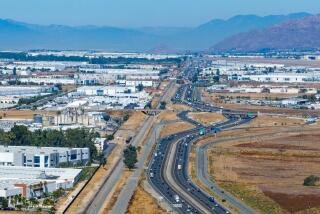A Tool Against Sprawl
- Share via
You can pay me now or pay me later, warns the mechanic in the car maintenance ads. Each growing city faces a similar choice in deciding when to stop spreading outward and to get serious about finding better ways to use the area it has to work with.
There are two options:
* The city can keep sprawling until it has reached immovable geographic limits in all directions--nonnegotiable boundaries such as an ocean, an unbuildable mountain range or another city expanding from the opposite direction.
* Or its residents and elected officials can resolve to create their own immovable limits, even if they are merely lines on the map.
The first approach is easy. It doesn’t take much creativity or political will to keep approving individual development proposals as if they were isolated projects with no cumulative effect. After enough years of this, and after geographic limits are reached, choosing to rebuild more efficiently is a no-brainer; it’s the only option. But by then there is little farmland or open space left to preserve.
The second approach leaves more possibilities for future generations. But it requires saying no to growth patterns that serve the needs of some mighty persuasive constituencies, from land speculators and the building industry to aspiring home buyers and overcrowded school districts.
Taking this tougher, better course demands strong public policy that will reinforce the good intentions of elected officials. One good tool is legally enforceable greenbelt agreements.
On Tuesday the Board of Supervisors and the Fillmore City Council should give final approval to the largest greenbelt in Ventura County’s history, a 72,000-acre swath of farmland stretching from Fillmore east to the Los Angeles County line on both sides of California 126.
The agreement would declare that area off-limits to development--most pointedly, off-limits to westward expansion of the controversial Newhall Ranch project, which would build homes for 70,000 new residents astraddle California 126 on the Los Angeles County side of the line. Ventura County supervisors have fought vigorously to stop or downsize Newhall Ranch. The greenbelt would at least keep it from sprawling into Ventura County, where the Newhall Land & Farming Co. owns another 15,000 acres.
The greenbelt would not forbid building in the area but would require both Ventura County and the city of Fillmore to inform the public of any planned changes to boundaries. Such changes would require a four-fifths approval by county supervisors and the Fillmore City Council.
Those requirements, and the fact that this greenbelt is being adopted as an official ordinance rather than as an informal handshake agreement, sets this one apart from the county’s six other farm zones.
Pushed hard by county Supervisor Kathy Long, the Fillmore greenbelt would be the first tangible move to carry out the wishes of the 69% of Ventura County voters who supported Measure A on the November 1988 ballot. That advisory measure called for giving the force of law to six current informal greenbelt agreements and creating another five greenbelts, exploring formation of a countywide land conservation district and developing a public education program on land-use issues.
Other Ventura County communities are also working to create greenbelts and limit urban sprawl. Oxnard has moved to save a 4,600-acre zone created years ago in an agreement with Ventura. In Ojai, officials want to save 10,000 acres for orchards and pastures. And the county is looking into buying chunks of the 2,700-acre Tierra Rejada greenbelt, created in 1982 and separating the cities of Simi Valley, Moorpark and Thousand Oaks.
Greenbelts have a similar aim to the Save Open Space and Agricultural Resources (SOAR) initiatives, which require a public vote before land currently zoned agricultural, rural or as open space could be rezoned for development.
We support more and stronger greenbelts, in accord with our belief that keeping agriculture and housing apart is the best way to ensure the healthy success of both.
If the new greenbelt is approved this week, Fillmore will be surrounded by about 165 square miles of open space--open space that will still be available for future generations to make decisions about. Its boundaries are indeed only lines on the map. Protecting those boundaries will be the job of active communities, resolute public officials and vigilant voters.
More to Read
Sign up for Essential California
The most important California stories and recommendations in your inbox every morning.
You may occasionally receive promotional content from the Los Angeles Times.













